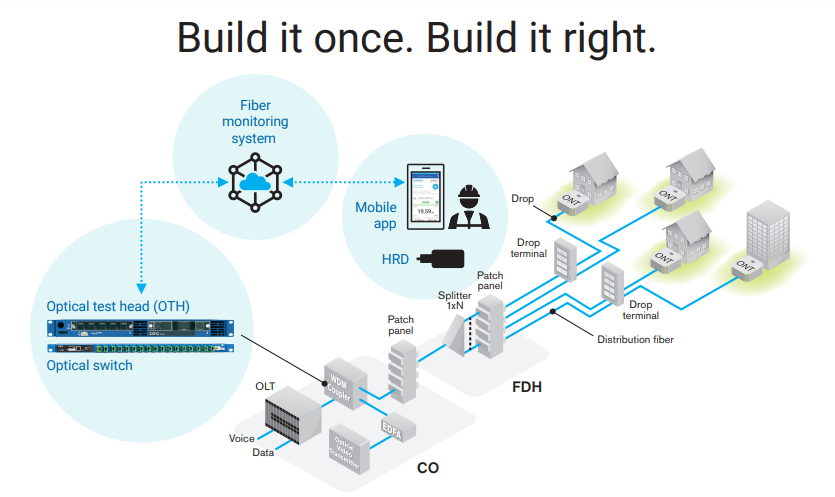Fibre providers must innovate to deliver fibre fit for our post-pandemic and future needs, as Wim te Niet, vice president, sales EMEA, EXFO tells VanillaPlus.
The Fibre market is currently experiencing a period of rapid growth, is it just 5G driving this and are deployments happening fast enough? Fibre is indeed growing fast, but nowhere near fast enough.
Yes, 5G is one big driver, and it is forecasted that we need 60x more fibre to be deployed to support that, alone. However, beyond this the post-pandemic shift to work-from-home and hybrid working is driving significant movement in the fibre-to-the-home (FTTH) and fibre-to-the-premises (FTTP) sectors, too.
Overall, we have seen a step-change in deployment pace, but it is simply not fast enough and being hindered by out-of-date build-out and operations practices.
Today tens of millions of homes and businesses are still being underserved. For example, the total number of homes yet to be passed in the UK and Germany is approximately 59 million.
That number is staggering. How far away are we from a full fibre coverage across Europe?
While some countries are close to full FTTB/FTTH coverage, such as Portugal (83%), Spain (88%) and Iceland (90%), many are far behind.
In the UK, coverage is around 15% with nearly 24 million homes still to be passed with fibre. At 16%, Germany is at a similar percentage as the UK, with nearly 35 million as I mentioned earlier.
But across Europe, the coverage rate is typically only 50% or less.
The good news is that countries are looking forward to a period of rapid FTTB/H expansion. The UK is expecting to pass an additional 19 million homes by 2025, with Italy and Germany adding 10 million and 16 million, respectively, in the same time period.
If those forecasts are reached that would place the UK, France, Italy and Germany in the top five European countries by FTTB/H homes passed.
The forecasted growth for the UK’s network is, indeed, impressive. I saw your announcements with Openreach and Hyperoptic earlier this year, can you tell me more about those?
Yes, we are very excited that both Openreach and Hyperoptic have selected our NovaFibre automated testing technology to help them deliver world-class FTTP networks across the UK.
As both these industry leading providers know, the profitability of fibre networks depends on maximising successful deployments and minimising service impacting faults. This may sound intuitive, yet in practice high failure rates are often tolerated, especially when it comes to construction. Current fibre deployment strategies often result in failure rates as high as 10%-15%.
These kinds of failures at the delivery stage increase both truck-rolls and time to first revenue, but can also negatively impact brand reputation which isn’t a great combination for any provider looking capitalise on the demand for fibre in this highly competitive market.
Success in this market will be marked by those who are able to accelerate the pace of build-out and turn-up, whilst reducing cost.
Do more, faster, better and cheaper is easy to say, but many providers will testify to the complexity and cost of exhaustive fibre testing. How can providers achieve accelerated deployment without escalating costs?
Our advice here is simple – test early, test frequently. Getting cables installed and activated right-first-time is critical. Not doing so impacts revenues and reputation while also tying up expensive resources further down the line.
When it comes to testing early, it’s about testing fibres at the point of installation. Flexible, cloud-based fibre testing tools that can easily be used by engineers and contractors to test entire bundles during construction and build are being used by some of the leading providers to cut installation failures from the 10%-15% range down to less than 1%.

This, alone, is a game changer, automated smartphone-based testing tools enable less-skilled resources to conduct thorough, accurate testing, thereby cutting costs and freeing up expert engineering resources to focus on more complex tasks.
Poor QoE costs providers up to $8 (€7.07) per customer, per year. For an operator with 50 million subscribers that means diverting $40 million (€35.36 million) per year into customer retention, rather than deploying new fibre.
Today, only 5% of fibre networks are actively monitored and less than 3% of service impacting issues detected. This is already inadequate, but as our societies becoming increasingly fibre dependent, continuing like this will be catastrophic for providers.
Is this depth of testing really necessary? Many providers use application layer testing to identify faults already.
Yes, it is absolutely necessary for providers looking to expand at pace, while still delivering to QoE expectations.
Multi-layer network monitoring provides the ability to prioritise and resolve service impacting faults before they become revenue impacting.
Achieving this means building a detailed, real-time monitoring and insights that spans from the application layer all the way through to Layer 0.
Operations centres are already stretched, the volume of data you’re advocating here seems unmanageable. What am I missing?
You’re spot on. NOCs, and SOCs, are dealing with hundreds of thousands of alarms and alerts most of it is just noise, but some of them are critical.
In one example, we spoke with a provider who noticed a backhaul link drop from 10Gbps (CPRI-8) to 622Mbps (CPRI-1). They detected this through congestion alarms, and after a lengthy investigation found an accidental micro-bend in a patch cable.
In this case, being able to correlate higher layer network and service monitoring with optical link monitoring would have identified the route cause immediately, saving customer frustration, and the provider time and money.
However, as you mentioned, even though providers are well adept at dealing with vast lakes of data, what we’re talking about here could multiply this by an order of magnitude, or more. This is where machine leaning (ML) can make the difference.
We’re surrounded by AI hyperbole, why do you think ML will work here?
Agreed, AI often gets touted as a magic wand for everything, but we believe there are specific, achievable applications of ML in the network assurance space that can really help providers build-out and turn-up high-quality fibre networks at speed, with high-reliability and operational performance.
ML is well suited to rapidly determine patterns in multi-dimensional data sets, such as multi-layer network monitoring, across both technical and organisational silos.
The increased speed at which the root cause can be triaged using ML lowers overall cost of identification, reduces mean time to resolution (MTTR) and increases customer satisfaction.
Any final comments?
European FTTB/H is experiencing a dramatic growth period, and, although the market is extremely competitive, forward-thinking providers can still emerge as industry leaders.
As the old saying goes, “a stitch in time saves nine” implementing Layer 0 testing at the very earliest point of the fibre operation will be crucial in determining the future success and profitability of networks.
Then, as networks build-out with inbuilt optical testing, applying more advanced multi-layered AI-driven analysis will further differentiate providers.
Ultimately, the collective business and community dependency on fibre-enabled connectivity is rapidly deepening. As such it would be negligent not to monitor fibre to the same degree, if not more, as copper is today from build-out to operations, Layer-0 to Layer-7, 24×7.
Sources:
- FTTP/H homes passed statistics: IDATE for FTTH Council Europe
- 60x additional fibre: Commscope – Powering the future of small cells and beyond, 2018
- Country level coverage statistics: FTTH Council Europe’s 2021 Market Panorama report
- Cost of poor QoE: Portevo Consulting, 2020
- Percentage fibre monitored: Exfo research
- Percentage of service impacting issues detected: James Crawshaw – Heavy Reading survey July 2019
- Deployment failure rates: Tier 1 Network Provider EXFO case study.
Comment on this article below or via Twitter: @VanillaPlus OR @jcvplus






